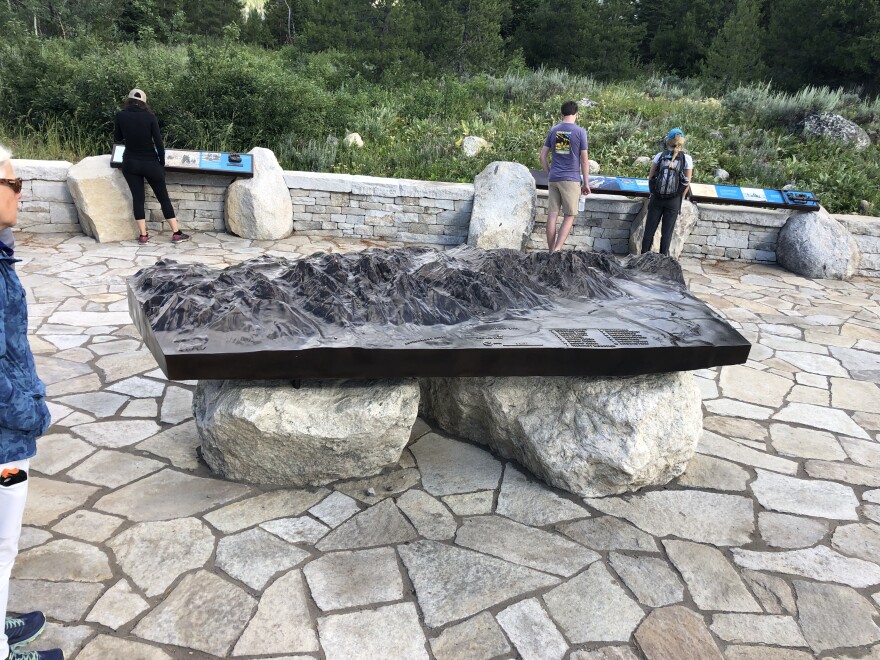Jenny Lake is one of the most popular destinations in Grand Teton National Park. The area got an upgrade approaching $20.5 through a partnership between the park and its foundation, the Grand Teton National Park Foundation. It mostly focused on trail improvements, orientation and key infrastructure. But it also made an effort to become more accessible for people with disabilities.
On a warm, sunny morning I met with Grand Teton National Park rangers under the flagpole at the enhanced Jenny Lake visitor center.
"It's nine o'clock this morning, and already you can see that the plaza is filled with people. There's lots of people arriving, and it will get busier as the day goes on," said Andrew Langford, the Jenny Lake district interpreter.
He's been a ranger for roughly 25 years, and a lot of that time has been spent at Jenny Lake. The so-called, "front country" is where the visitor center building, plaza and store is located.

People wander through the plaza looking at panels on the ecosystem and wildlife they may encounter. There's also a 12-foot-wide bronze 3-D map of the area.
"It was designed specifically for someone who is visually impaired to feel the silhouette of the mountain range. And so you can see features that are very detailed for example the Teton fault is visible," said Langford as he started to point at part of the map.
I put my hand where Langford pointed and felt a crack right along the mountain base. That crack represents the Teton Fault.
"We've tried to focus on accessibility," Langford told me. "The entire project in the front country is accessible in terms of physical abilities but also beyond that."
Accessibility has become a focus for the National Park Service. Back in 2015, the service was having a conversation about whether it was being inclusive enough to everyone. It realized that visitors to national parks have some disabilities and are also older or aging.
"As people get older and as they age, they are more likely to acquire disabilities so to maintain our current visitorship we also had to look at how we become accessible as people age into disability," said Jeremy Buzzell, branch chief for housing and accessibility for the National Park Service.

He said the great thing about accessibility is that a lot of the features end up being beneficial for all visitors.
"We do a lot of work where we put out tactile experiences for people who are blind. We might make a tactile model of the Grand Canyon or a tactile model of some kind of monument, well those are really popular with kids as well. Those kids can see but their getting the benefit of physically interacting with that," said Buzzell.
We left the visitor center plaza and took the path towards the lake. Along the path, there are interactive stations that continue to give visitors an idea about what the area is all about. This includes models of wildlife poop for a couple of species including the black bear and moose that are crafted by a sculptor. If visitors use an app, they can scan it and a black bear or moose will appear on the landscape. They've also developed a couple of concrete ramps to make it easier for someone to take a wheelchair up to the water.
"I saw someone in a wheelchair down here yesterday. I think almost every day there's someone in a wheelchair here. Before the project, they could not get close or into the water," said Langford.
Areas like national parks are a challenge for those with disabilities. But Kevin Stickelman, the CEO of the National Ability Center, praised the effort to make things more accessible.
"People who have different abilities are just as fascinated by the national wonders that the parks present as to the able bodied population, and they would like to go experience the same sights, sounds and wildlife and recreation and everything within the extent of their ability," he said.
The accessibility has also been extended to the backcountry of Jenny Lake.

On the West side of the lake, we began on a mile hike to Inspiration Point. It's an elevation gain of 450 feet. We hiked past a newly built bridge, and the rangers pointed out parts of the trail which have been made easier to maneuver. However, there's also a drop off one side with a sheer cliff on the other. But Langfordrecalled one visitor taking it on.
"I remember coming across a gentlemen who was 78 years old clinging to the cliff in fear. He was standing on the trail but on the cliff face he had both hands up he was clinging to that cliff face in absolute terror. And, I asked him, 'I'll help you down,' and he said, 'I'm not going down and I'm going up,'" Langford recalled.
Langford said the man made it.
"For a lot of people getting to Inspiration Point is like climbing the Grand Teton or climbing Mount Everest. It's a major accomplishment for them."
This is what the project at Jenny Lake hopes to achieve: giving the opportunity to everyone to challenge themselves to experience the wilderness.








